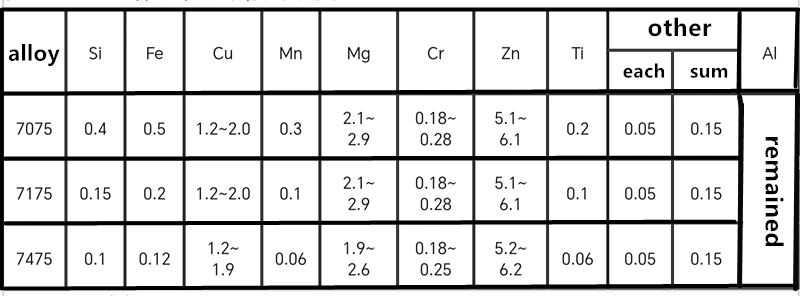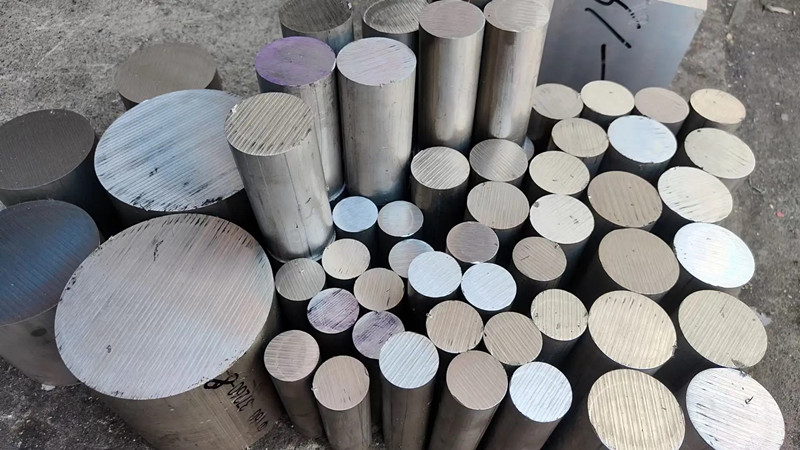7 properties of 7075 aluminum alloy
Comprehensive Overview of 7075 Aluminum Alloy
7075 aluminum alloy is a high-strength aluminum alloy primarily composed of zinc, with magnesium, copper, and other elements added. As a member of the Al-Zn-Mg-Cu series, it is a heat-treatable, ultra-high-strength wrought alloy. Due to its outstanding properties, 7075 aluminum is widely used in aerospace, mechanical manufacturing, and high-end mold processing. This article provides a detailed introduction to the characteristics of 7075 aluminum alloy, covering its physical and chemical properties, heat treatment, electrical conductivity, aging process, mechanical properties, and processing characteristics.

1. Physical and Chemical Properties
The melting temperature range of 7075 aluminum alloy is 477°C to 638°C, with a density of approximately 2.81 g/cm³. Its thermal conductivity at different temperatures is as follows:
25°C: 124 W/(m·°C)
50°C: 128 W/(m·°C)
100°C: 142 W/(m·°C)
125°C: 147 W/(m·°C)
150°C: 157 W/(m·°C)
200°C: 170 W/(m·°C)
These values indicate that the thermal conductivity of 7075 aluminum alloy increases as temperature rises, making it suitable for components requiring excellent heat dissipation. Additionally, 7075 aluminum has relatively low corrosion resistance and often requires surface treatments, such as anodizing, to enhance its anti-corrosion performance.
2. Heat Treatment
7075 aluminum alloy is a typical heat-treatable alloy whose performance largely depends on its heat treatment process. The main heat treatment states include:
T6 State:
Solution heat treatment followed by artificial aging, resulting in the highest strength. However, it has lower toughness, sensitivity to stress corrosion cracking, and decreased toughness at low temperatures.
Suitable for applications requiring high strength but not high corrosion resistance, such as mechanical parts and high-strength structural components.
T73 State:
Solution heat treatment followed by over-aging, which reduces strength but significantly improves fracture toughness, stress corrosion resistance, and exfoliation corrosion resistance.
Commonly used in aerospace components where safety and reliability are critical.
T76 State:
Optimized over-aging treatment providing higher strength than the T73 state and better stress corrosion resistance than the T6 state.
Ideal for applications requiring a balance of strength and corrosion resistance.
3. Electrical Conductivity
The electrical conductivity of 7075 aluminum alloy is lower compared to other aluminum alloys but still sufficient for certain electrical applications. Heat treatment affects its conductivity, with over-aging treatments (e.g., T73) generally increasing conductivity and artificial aging (e.g., T6) decreasing it due to changes in microstructure and precipitation phases.
4. Aging Process
The aging treatment for 7075 aluminum alloy includes natural aging and artificial aging:
Natural Aging: After solution treatment, the alloy is stored at room temperature, allowing the precipitation of strengthening phases to increase strength, though the effect is less significant compared to artificial aging.
Artificial Aging: After solution treatment, the alloy is held at a specific temperature for a defined period to promote precipitation and optimize mechanical properties. Typical aging conditions include:
T6 State: 120–130°C for 10–12 hours.
T73 State: 160–180°C for 24 hours or more.
Optimizing the aging process is crucial for achieving the desired balance of strength, toughness, and corrosion resistance.
5. Mechanical Properties
7075 aluminum alloy is known for its exceptional strength and fatigue performance, making it a preferred material in aerospace applications. Compared to 2024 and 2124 alloys, its static strength is significantly higher, while its fatigue performance is comparable. Key mechanical properties of 7075-T6 include:
Tensile Strength: 572–610 MPa
Yield Strength: 503–540 MPa
Elongation: 6%–11%
Hardness: 150–160 HB
In contrast, the T73 state has slightly lower strength but offers improved toughness and corrosion resistance. Additionally, the alloy exhibits reduced toughness at low temperatures, making it unsuitable for extreme cold environments.
6. Processing Characteristics
7075 aluminum alloy has excellent machinability and is suitable for various processes such as turning, milling, and drilling. Key considerations include:
Machinability:
The T6 state has high hardness, which makes it easy to machine but can cause faster tool wear.
T73 and annealed states have lower hardness and are easier to machine.
Formability:
In annealed (O) or solution-treated (W) states, 7075 aluminum has excellent room-temperature formability, allowing complex shapes to be produced through stretching or bending.
Weldability:
The weldability of 7075 aluminum is relatively poor due to its susceptibility to cracking in the heat-affected zone. Mechanical fastening or adhesive bonding is often preferred.
Surface Treatment:
Due to its low corrosion resistance, particularly in chloride environments, anodizing or coatings are recommended to enhance durability.
7. Applications
Thanks to its outstanding strength and fatigue performance, 7075 aluminum alloy is widely used in the manufacture of high-strength, lightweight components, including:
Aerospace: Aircraft skins, wing spars, frames, stringers, landing gear, and hydraulic system components.
Mold Manufacturing: High-end mold bases for high-load applications.
Mechanical Equipment: High-strength mechanical parts and support structures.
It is important to note that the operating temperature of 7075 aluminum alloy should not exceed 125°C to maintain its mechanical properties.
Conclusion
7075 aluminum alloy is a versatile and high-performance material widely used in aerospace and high-end manufacturing. By selecting the appropriate heat treatment state and employing suitable surface treatments, it can meet the demands of various applications, showcasing its position as a leader among high-strength materials.
